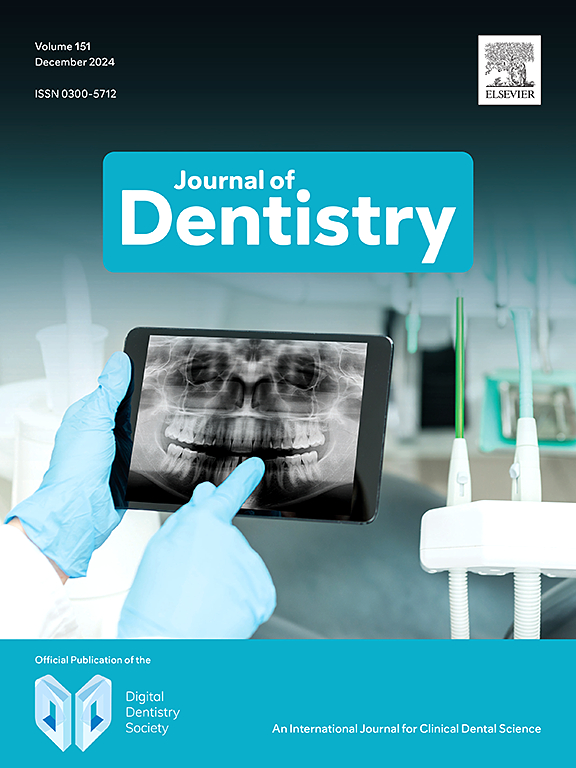Efficacy and safety of peroxide-based mouthrinse on whitening treatment: A randomized controlled clinical trial
IF 4.8
2区 医学
Q1 DENTISTRY, ORAL SURGERY & MEDICINE
引用次数: 0
Abstract
Objectives
This randomized controlled clinical trial evaluated the efficacy and safety of peroxide-based mouthrinse on whitening treatment. The patient's satisfaction and treatment longevity were also assessed.
Material and methods
Participants (N = 45) were randomly allocated to three different groups: WM (Whitening mouthrinse – 2.5% hydrogen peroxide); PM (Placebo mouthrinse – 0% hydrogen peroxide); and WG (Whitening gel - 10% carbamide peroxide). The treatment was performed twice daily for 30 s over 90 days for WM and PM and once daily for 2 h over 14 days for WG. Tooth color was evaluated with shade guides (ΔSGU) and with a spectrophotometer (ΔE00 and WID) after 14, 30, 60, 90, 120 days, and 2 years. Tooth sensitivity, gingival condition, and patient satisfaction were also evaluated.
Results
WG resulted in the highest color change over time for visual (ΔSGU) and objective (ΔE00 and WID) analyses. With WM, significant visual color alteration was detected in the 60-day assessment compared with PM. After 2 years, no color rebound was observed for the treatments. A very low intensity of sensitivity was found for WM and WG. No gingival irritation was detected. All the participants were satisfied with the whitening treatment outcomes.
Conclusions
The peroxide-based mouthrinse effectively changed tooth color, with relevant effect detected after 60 days of use. However, the whitening result obtained with the conventional carbamide peroxide gel treatment was more pronounced. No relevant adverse effects were observed, and the outcomes were maintained for 2 years.
Clinical significance
Peroxide-based mouthrinse is an effective alternative whitening treatment, although it promotes less color change compared with the conventional at-home technique without inducing significant adverse effects. Patients should be warned about the prolonged treatment and the need for compliance.
求助全文
约1分钟内获得全文
求助全文
来源期刊

Journal of dentistry
医学-牙科与口腔外科
CiteScore
7.30
自引率
11.40%
发文量
349
审稿时长
35 days
期刊介绍:
The Journal of Dentistry has an open access mirror journal The Journal of Dentistry: X, sharing the same aims and scope, editorial team, submission system and rigorous peer review.
The Journal of Dentistry is the leading international dental journal within the field of Restorative Dentistry. Placing an emphasis on publishing novel and high-quality research papers, the Journal aims to influence the practice of dentistry at clinician, research, industry and policy-maker level on an international basis.
Topics covered include the management of dental disease, periodontology, endodontology, operative dentistry, fixed and removable prosthodontics, dental biomaterials science, long-term clinical trials including epidemiology and oral health, technology transfer of new scientific instrumentation or procedures, as well as clinically relevant oral biology and translational research.
The Journal of Dentistry will publish original scientific research papers including short communications. It is also interested in publishing review articles and leaders in themed areas which will be linked to new scientific research. Conference proceedings are also welcome and expressions of interest should be communicated to the Editor.
 求助内容:
求助内容: 应助结果提醒方式:
应助结果提醒方式:


